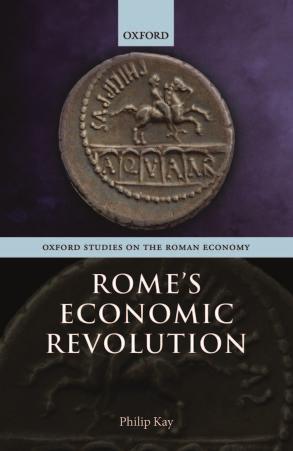Rome's Economic Revolution by Philip Kay

Author:Philip Kay [Kay, Philip]
Language: eng
Format: epub, pdf
Tags: Business & Economics, Economic Conditions, Economic History, History, Ancient, General, Rome, Social Science, Archaeology
ISBN: 9780199681549
Google: v9XQAgAAQBAJ
Publisher: OUP Oxford
Published: 2014-01-15T03:20:00.241000+00:00
Trade, Capital, and Interconnected Markets
191
state reserves and temple treasures, into circulation again and put them to
productive use.
Just as the commercial revolutions of the thirteenth and sixteenth centuries ad
seem to have been driven by trade, so the evidence for an increase in trade in the
Roman world in the second half of the second century bc is also very compelling.
We discussed in the previous chapter the export of central Italian wine to western
Europe. The trade that developed in the eastern Mediterranean, which we shall
now examine, was equally striking. Strabo relates that, between the years 166 and
87, the island of Delos was transformed into the most important emporium in the
eastern Mediterranean and more specifically into the centre of a trade in slaves
and luxury goods.13 We can deduce from epigraphic evidence that negotiatores
(‘merchants’ or ‘businessmen’) and trapezitai (‘bankers’) from numerous points
in the Mediterranean installed themselves on Delos and that a large cosmopolitan
community developed.
C I C E R O
As we have repeatedly mentioned, one major problem we immediately face in
attempting to trace the development of the Roman private sector during the
second half of the second century and the beginning of the first century is that
the vast bulk of the source evidence for wealth creation in the Roman world
during the Republican period comes from the years 70 to 40, thanks to the
Ciceronian corpus, in particular his letters, and that no equivalent source is
available for our period. As Hatzfield commented in 1919: ‘Far from being
surprised by finding a quantity of [sc. epigraphic] texts in Asia relating to
Romaioi, on the contrary one must deplore the fact that we possess so little of
them and resign oneself to the fact that they give us only an insufficient idea of the
number of negotiatores and of their activity.’14
This difficulty has been justifiably highlighted, for example by Kallet-Marx,
who, in the context of the province of Asia, argues that the consequences of its
creation as a Roman province have been largely overvalued by historians and that
the real starting point of control and exploitation of the province was the re-
establishment of Roman control by Sulla, followed by its extension under Lucullus
and Pompey.15 Ferrary, on the other hand, sees a reasonably steady progression
from the establishment of the Asian province to the time of Cicero. He believes
that the presence of a magistrate in the province was a guarantee of security and
also made it possible (for Romans, but also for Latins and indeed Italians) to find,
on the spot, a competent magistrate to regulate disputes.16 Be that as it may, we
possess truly precise and abundant information only for the time of Cicero and
the problem is to decide what it is legitimate to infer about private wealth creation
for the decades between the establishment of the province of Asia and the
Mithradatic crisis.
13 Strabo, 10. 5. 2.
14 Hatzfeld 1919: 46.
15 Kallet-Marx 1995a: 125–60.
16 Ferrary 2001, 2002.
Download
This site does not store any files on its server. We only index and link to content provided by other sites. Please contact the content providers to delete copyright contents if any and email us, we'll remove relevant links or contents immediately.
International Integration of the Brazilian Economy by Elias C. Grivoyannis(88469)
The Radium Girls by Kate Moore(11900)
Turbulence by E. J. Noyes(7920)
Nudge - Improving Decisions about Health, Wealth, and Happiness by Thaler Sunstein(7547)
The Black Swan by Nassim Nicholas Taleb(6989)
Rich Dad Poor Dad by Robert T. Kiyosaki(6361)
Pioneering Portfolio Management by David F. Swensen(6208)
Man-made Catastrophes and Risk Information Concealment by Dmitry Chernov & Didier Sornette(5900)
Zero to One by Peter Thiel(5661)
Secrecy World by Jake Bernstein(4619)
Millionaire: The Philanderer, Gambler, and Duelist Who Invented Modern Finance by Janet Gleeson(4352)
The Age of Surveillance Capitalism by Shoshana Zuboff(4192)
Skin in the Game by Nassim Nicholas Taleb(4144)
Bullshit Jobs by David Graeber(4068)
The Money Culture by Michael Lewis(4051)
Skin in the Game: Hidden Asymmetries in Daily Life by Nassim Nicholas Taleb(3907)
The Dhandho Investor by Mohnish Pabrai(3681)
The Wisdom of Finance by Mihir Desai(3629)
Blockchain Basics by Daniel Drescher(3474)
